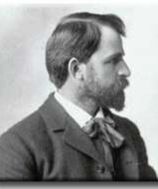Editing Garland's Works
 Senior Garland
Senior Garland
Scholarly editors of letters (those who locate, transcribe, edit, annotate, and then persuade a press to publish the results) have to deal with a plethora of practical and technical problems. Some practical issues range from deciding how many letters to publish, which letters will interest what readers, and the sort--and amount--of annotation to include. More technical concerns include how to present the manuscript letter (facsimile reproduction or edited transcription); and whether and how to present the writer's errors (should one correct typographical or grammatical errors? should one be scrupulously faithful to the manuscript and include exactly what the writer wrote, including cancellations and insertions?).
Garland was a prolific writer, publishing over 40 books, as well as being an excessively gregarious man. For the Selected Letters of Hamlin Garland (University of Nebraska Press, 1998), my co-editor (Joseph McCullough of UNLV) and I were faced with task of selecting 405 letters to include in the volume from over 5,000 letters scattered around the country. We intend the edition to be representative of a career that spanned 55 years of letter-writing to over 700 correspondents, who ranged from fellow writers to presidents, from college professors to fans, from artists and musicians to the cultural elite.
To illustrate the sort of letters I have grown to know perhaps too well, below is a holograph letter (in the handwriting of the author) to the playwright Augustus Thomas (1857-1934), author of over 60 plays, who was noted for his depiction of American background in such works as Alabama (1891), In Mizzoura (1893), The Capital (1895), and Arizona (1899). Garland had just seen Thomas's The Hoosier Doctor, which opened at the New National Theatre in Washington, D.C., on 22 April 1897. Thomas later became one of Garland's close friends. Garland's handwriting ranges from the merely illegible to the truly hair-pulling, scream-inducing awful.
But see for yourself:
Garland was a prolific writer, publishing over 40 books, as well as being an excessively gregarious man. For the Selected Letters of Hamlin Garland (University of Nebraska Press, 1998), my co-editor (Joseph McCullough of UNLV) and I were faced with task of selecting 405 letters to include in the volume from over 5,000 letters scattered around the country. We intend the edition to be representative of a career that spanned 55 years of letter-writing to over 700 correspondents, who ranged from fellow writers to presidents, from college professors to fans, from artists and musicians to the cultural elite.
To illustrate the sort of letters I have grown to know perhaps too well, below is a holograph letter (in the handwriting of the author) to the playwright Augustus Thomas (1857-1934), author of over 60 plays, who was noted for his depiction of American background in such works as Alabama (1891), In Mizzoura (1893), The Capital (1895), and Arizona (1899). Garland had just seen Thomas's The Hoosier Doctor, which opened at the New National Theatre in Washington, D.C., on 22 April 1897. Thomas later became one of Garland's close friends. Garland's handwriting ranges from the merely illegible to the truly hair-pulling, scream-inducing awful.
But see for yourself:
Analysis by Keith Newlin
Copyright © 2022
Copyright © 2022
